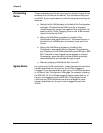
Cajun P550/P880/P882 Switch User Guide
Configuring Port Parameters
5-7
Automatic Binding of VLANs to Ports
When a VLAN is either manually or automatically created, the
software may automatically bind the VLAN to a port depending on
the setting of the ‘Trunk Mode’ parameter assigned to the port.
■ When a VLAN is created manually the software assigns the
VLAN to all ports whose ‘Trunk Mode’ is set to ‘Bind-to-All’. No
other ports will automatically be assigned when a VLAN is
created manually.
■ When a VLAN is created automatically the software assigns the
VLAN to the port it is received on if that port is set to 'Bind-to-
All' and 'Bind-to-Received". Additionally, software will assign
the VLAN to all other ports whose 'Trunk Mode' is set to 'Bind-
to-All'. No other ports will automatically be assigned when a
VLAN is created manually.
VLAN Operational Rules
VLANs are limited by physical switch domains. Users in various
physical locations that belong to the same workgroup can participate
in the same VLAN or multiple VLANs, as required. This helps
simplify network resource management.
VLAN Operation are based on three sets of rules:
■ Ingress Rules
■ Forwarding Rules
■ Egress Rules
Ingress Rules Every frame received by the switch is classified to exactly one VLAN.
There are two ways in which frames are classified to VLANs:
■ Untagged frames are classified to the VLAN associated with the
port on which the frame is received (Port-based VLANs)
■ Tagged frames are classified to the VLAN identified by the VLAN
tag in the tag header of the frame


















